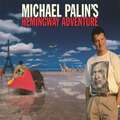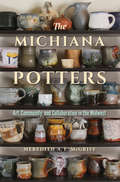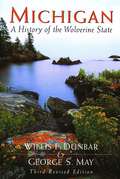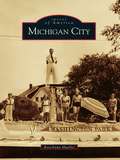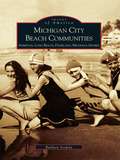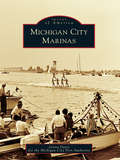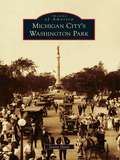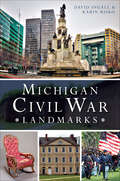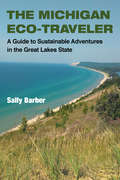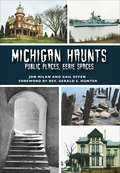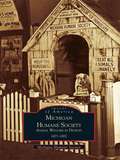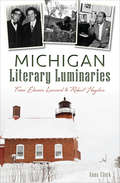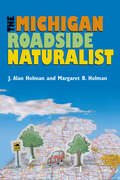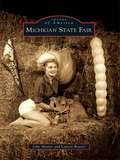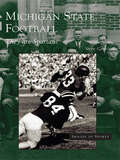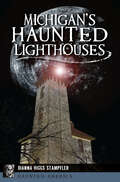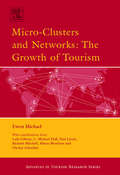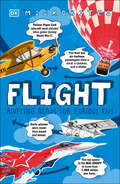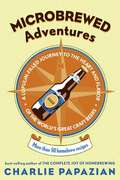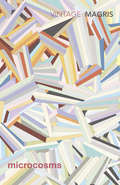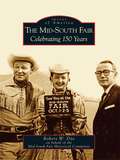- Table View
- List View
Michael Palin's Hemingway Adventure
by Michael PalinA winning combination of No.1 travel writer Michael Palin and one of the great literary figures of the century.When Michael Palin was researching for his novel HEMINGWAY'S CHAIR his interest was stimulated by Hemingway's appetite for travel and 'Papa's' evocations of the places he knew. Hemingway remains a compelling figure, and Palin's goal was to revisit Hemingway's world. This book includes the American West ('wide lawns and narrow minds'), Idaho, Michigan ('fly fishing, hunting'), Europe in the First World (where Hemingway was wounded serving in the Ambulance Brigade), Cuba (where Hemingway wrote FOR WHOM THE BELL TOLLS), Paris in the Roaring Twenties and Spain during the Spanish Civil War, Sun Valley and Key West - where the Hemingway lookalike competition is an annual event.
Michael Palin's Hemingway Adventure
by Michael PalinWhen Michael Palin was researching for his novel HEMINGWAY'S CHAIR his interest was stimulated by Hemingway's appetite for travel and 'Papa's' evocations of the places he knew. Hemingway remains a compelling figure, and Palin's goal was to revisit Hemingway's world. This book includes the American West ('wide lawns and narrow minds'), Idaho, Michigan ('fly fishing, hunting'), Europe in the First World (where Hemingway was wounded serving in the Ambulance Brigade), Cuba (where Hemingway wrote FOR WHOM THE BELL TOLLS), Paris in the Roaring Twenties and Spain during the Spanish Civil War, Sun Valley and Key West - where the Hemingway lookalike competition is an annual event.Read by Michael Palin(p) 1999 Orion Publishing Group
The Michiana Potters: Art, Community, and Collaboration in the Midwest (Material Vernaculars)
by Meredith A. McGriffA new pottery tradition has been developing along the border of northern Indiana and southern Michigan. Despite the fact that this region is not yet an established destination for pottery collectors, Michiana potters are committed to pursuing their craft thanks to the presence of a community of like-minded artists. The Michiana Potters, an ethnographic exploration of the lives and art of these potters, examines the communal traditions and aesthetics that have developed in this region. Author Meredith A. E. McGriff identifies several shared methods and styles, such as a preference for wood-fired wares, glossy glaze surfaces, cooler colors, the dripping or layering of glazes on ceramics that are not wood-fired, the handcrafting of useful wares as opposed to sculptural work, and a tendency to borrow forms and decorative effects from other regional artists. In addition to demonstrating a methodology that can be applied to studies of other emergent regional traditions, McGriff concludes that these styles and methods form a communal bond that inextricably links the processes of creating and sharing pottery in Michiana.
Michigan: A History of the Wolverine State
by Willis F. Dunbar George S. MayThis standard textbook on Michigan history covers the entire scope of the Wolverine State's historical record -- from when humankind first arrived in the area around 9,000 B.C. up to 1995. This third revised edition of Michigan also examines events since 1980 and draws on new studies to expand and improve its coverage of various ethnic groups, recent political developments, labor and business, and many other topics. Includes photographs, maps, and charts.
Michigan City
by Roseanna MuellerNestled on the southern-most shores of the Great Lakes, Michigan City was established in 1836. An abundance of pine and hardwoods gave rise to a thriving lumber industry, and by the end of the century, Michigan City was one of the largest lumber markets in the state. The city's harbor and the arrival of the railroad brought new industry, from the manufacture of rail cars to glassmaking and flour mills. Michigan City even pitted itself against Chicago in a race to become the major port on Lake Michigan. The early twentieth century saw a rise in tourism as lakefront attractions sprang up. Excursionists arrived by boat and train for bathing, shooting galleries, a merry-go-round and roller coaster, and the Oasis Ballroom. As a result of the city's dune preservation efforts in the 1960s and 1970s, the city continues as a haven for water sports and a resort for Chicagoans and others in the Midwest.
Michigan City Beach Communities: Sheridan, Long Beach, Duneland, Michiana Shores
by Barbara StodolaSituated along the southern shores of Lake Michigan, between Mount Baldy and the Indiana-Michigan border, is a unique Midwestern landscape. Established at the foot of Hoosier Slide, a natural landmark, Michigan City had attracted a diverse group of pioneers, industrialists, and fun-lovers by the late 1800s. Hoosier Slide is now gone. While the rugged dunes in the east have been replaced by resort communities, the beauty that first captivated settlers is as evident now as it was in the early part of the 20th century.
Michigan City Lighthouse: Guardians of Lake Michigan
by Steven D. ElveIt was the year 1904, and the country was again ready to re-elect former "Rough Rider" Teddy Roosevelt to another four-year term in the White House. The Panama Canal was underway and the nation was growing, opening opportunities for those who would dare to dream and turn their hard work into reality. For Thomas J. Armstrong, it was a new position as head keeper of the Michigan City Light Station. This new title offers a glimpse into Michigan City maritime history, from the storm of 1913 that left the lighthouse practically buried in ice, to the capsizing of the Eastland on its way to Michigan City, one of the worst marine disasters in the history of the Great Lakes. The light would guide mariners until its relocation to the Michigan City Lighthouse Museum in 1980, where it is on display today.Michigan City Lighthouse is a collection of over 200 vintage photographs and postcards dated from 1909 through 1920, taken by lighthouse keepers Fred Dykeman, Thomas Martin, and Thomas Armstrong.
Michigan City Marinas (Images of America)
by Michigan City Port Authority Jonita DavisSince its incorporation, Michigan City has appreciated its lakefront assets. The point at which Trail Creek collides with Lake Michigan has always been a source of pride for the city's residents. However, it was not until 1959 that an agency was created to protect and maintain the city's interests at the lakefront. Michigan City Marinas chronicles the agency's efforts to realize the potential of one of Lake Michigan's most magnificent ports. The people, events, and other government agencies that helped shape the future of the marinas are explored along with the Michigan City Port Authority's tenacious oversight of the resources and facilities that are still in use today.
Michigan City's Washington Park
by Jonita DavisThe sand dunes stretched higher than many skyscrapers, with the remnants of an abandoned lumber industry at their feet. The sandy, overgrown land was nothing that Michigan City residents cared to develop, let alone visit. The area was largely forgotten until Mayor Martin Krueger decided that his town would have a park and bathing beach. In a few short years, the deserted area was transformed into a family amusement center on Lake Michigan's southern shores. These beginnings helped shape the Michigan City community. However, the lakeside park and bathing beach of today barely resemble the famous amusement area of the early 1900s. Somewhere along this town's history, its greatest asset of that early time--its amusement park--transformed into a natural beauty that is still treasured by families today, though nostalgia remains for the park of the past. Michigan City's Washington Parks traces those lost amusement years with images and the complete amazing tale, from the building of the large wooden roller coaster with a lake view to the communal turn toward a nature park.
Michigan Civil War Landmarks (Civil War Series)
by David Ingall Karin RiskoWhen America faced its greatest internal crisis, Michigan answered the call with over ninety thousand troops. The story of that sacrifice is preserved in the state's rich collection of Civil War monuments, markers, forts, cemeteries, reenactments, museums and exhibits. Discover how General George A. Custer and the famed Michigan Cavalry Brigade "saved the Union." Visit the chair that President Lincoln was assassinated in at Ford's Theatre, and view the grave of the last African American Union veteran. With a foreword by Civil War historian Jack Dempsey, this work is the first of its kind to chronicle the many Civil War landmarks in the Wolverine State.
The Michigan Eco-Traveler: A Guide to Sustainable Adventures in the Great Lakes State
by Sally BarberMichigan offers some of the most wonderfully diverse recreation opportunities in the country. The Michigan Eco-Traveleris for a new and growing breed of leisure traveler and adventurer--the individual seeking to experience the pleasant peninsulas responsibly by minimizing his or her eco-footprint. The book introduces readers to the importance of eco-friendly travel and highlights some of the best eco-conscience venues across the state that offer activities from golfing to skiing to sailing and much more. The book also examines environmental pressures on the state's recreational resources, revealing the critical need for joining together in conservation practices, and offers travelers helpful tips for evaluating the sustainability of their own favorite recreational spots. Whether you're a weekend traveler, extreme adventurer, or family on vacation, The Michigan Eco-Travelerlights the way to a greener getaway. Naturalists, conservationists, and hospitality experts will find the book equally helpful in responding to the ever rising demand for sustainable recreation.
Michigan Haunts: Public Places, Eerie Spaces (Haunted America)
by Jon Milan Gail OffenA ghostly travel guide to the Great Lakes State. Michigan has two beautiful peninsulas that are connected by stories, legends, and mysteries. This book is the perfect glove compartment companion for exploring those paranormal parts of the Mitten State, as most of these hotels, restaurants, theaters, lighthouses, and other places are open to the public. This road trip to &“the other side,&” filled with hauntings, ghost towns, and bizarre tales of murder and mayhem, draws from more than 300 years of Michigan history—from the notoriously haunted remote lighthouses like Seul Choix in the Upper Peninsula to Eloise, one of the most famous psychiatric asylums in America to the legend of Lover's Leap on Mackinac Island. What Purple Gang member still hangs out in Clare? What spirits lurk at Henry Ford's Greenfield Village? Here is a guide to all that and more, including Houdini&’s Detroit connections, the poisonings at Cass Corridor&’s Alhambra, and paranormal activity at Detroit&’s historic Fort Wayne. Puzzles are still waiting for a solution; Ripley&’s Believe it or Not! once offered $100,000 to anyone who could solve the strange phenomenon of the Paulding Lights near Watersmeet. So, buckle up and prepare to explore the eeriest the Wolverine State has to offer.<
Michigan Humane Society: Animal Welfare in Detroit, 1877-2002
by Michigan Humane SocietyThroughout its 125 years of service, the Michigan Humane Society has played an integral role in the development of Detroit and its commitment to social service. Early policy makers, officers, and board members of the Michigan Humane Society included prominent Detroiters such as Henry Ford, Mr. and Mrs. Abner Larned, Frank Cody, Mrs. Henry Ledyard, Mr. and Mrs. John Dodge, and Thomas W. Palmer, who later went on to become a U.S. Senator. These dedicated individuals possessed a vision that set the course for today's Michigan Humane Society. Early Society efforts focused on improving the working conditions and treatment of the city's work horses, protecting women and children from abuse and neglect, and teaching humane values. Today's Michigan Humane Society provides for the rescue, shelter, veterinary care, and placement of domestic animals, as well as the rescue, rehabilitation, and relocation of wild and exotic animals.
Michigan Literary Luminaries: From Elmore Leonard to Robert Hayden
by Anna ClarkDiscover the novelists, poets, and others who are part of this Midwestern state&’s rich literary tradition. From Ernest Hemingway&’s rural adventures to the gritty fiction of Joyce Carol Oates, the landscape of the &“Third Coast&” has inspired generations of the nation&’s greatest storytellers. Michigan Literary Luminaries shines a spotlight on this rich heritage of the Great Lakes State. Discover how Saginaw greenhouses shaped the life of Pulitzer Prize–winning writer Theodore Roethke. Compare the common traits of Detroit crime writers like Elmore Leonard and Donald Goines. Learn how Dudley Randall revolutionized American literature by doing for poets what Motown Records did for musicians, and more. With a mixture of history, criticism, and original reporting, journalist Anna Clark takes us on a surprising literary tour.
The Michigan Roadside Naturalist
by Margaret B. Holman J. Alan HolmanDid you know . . . ? * Michigan is seventeenth in oil production in the United States. * The Great Lakes are said to be the only glacially produced structures that can be seen from the moon. * Michigan was once part of a coral reef. * The wood frog is one of the commonest true frogs of moist woodland floors in Michigan today and is able to freeze solid during the winter without harmful effects. These and many more amazing facts await the curious traveler in The Michigan Roadside Naturalist, J. Alan and Margaret B. Holman's captivating guide to the natural treasures of Michigan. A perfect accompaniment to the classic Michigan Trees and The Forests of Michigan, this user-friendly guide offers a Who's Who of the geology, biology, and archaeology of the Great Lakes State, as well as highway adventures along the state's major routes. The book begins with an educational yet accessible tour of important points in Michigan's natural and archaeological history, followed by seven road trips based on commonly traveled state routes, moving from south to north in the Lower Peninsula and east to west in the Upper Peninsula. Readers can proceed directly to the road trips or familiarize themselves with the state's treasure trove of fascinating features before embarking. Either way, an informative and fun odyssey awaits the passionate naturalist, amateur or otherwise.
Michigan State Fair (Images of America)
by John Minnis Lauren BeaverFirst held in 1849 in Detroit, the location of the Michigan State Fair rotated in the early years between Detroit, Ann Arbor, Kalamazoo, Adrian, Jackson, Grand Rapids, East Saginaw, Lansing, and Pontiac before settling permanently in Detroit. When Detroit department store magnate Joseph L. Hudson sold 135 acres of Woodward Avenue farmland to the Michigan State Agricultural Society in 1905 for $1, the permanent home of the Michigan State Fair was established. On February 12, 2009, Michigan governor Jennifer Granholm signed an executive order effectively ending a 160-year tradition--the Michigan State Fair.
Michigan State Football: They are Spartans (Images of Sports)
by Steve GrinczelMichigan State University's football history is overflowing with famous, interesting, and colorful figures. From Gideon "Charlie" Smith, who in 1913 became one of the nation's first black collegiate players, to George Webster, the "Greatest Spartan of All Time," to Morton Andersen, who still holds the Big Ten record for longest field goal-they are all Spartans. Earl Morrall, Bubba Smith, Lorenzo White... the list goes on. Added to this list of tremendous players are legendary coaches like the "Biggie" Munn and Duffy Dougherty. And who could forget the famous 10-10 tie with Notre Dame in 1966 or the Rose Bowl victory over Southern Cal in 1987?Spartan tradition is more than the coaches and players on the field, however, and Michigan State Football: They Are Spartans offers many rare images and long-forgotten anecdotes about how the program became a player on the national stage. The early days as a farm college team, the development into a football power as an independent, the successful struggle to join the Big Ten conference, and of course, the historic rivalry with a certain team from Ann Arbor are all recounted in the pages of this book.
Michigan's Haunted Lighthouses (Haunted America)
by Dianna StampflerTravel Michigan&’s coast—and into the state&’s history—with otherworldly tales of the spirits of those who sought to keep its waters safe. Michigan has more lighthouses than any other state, with more than 120 dotting its expansive Great Lakes shoreline. Many of these lighthouses lay claim to haunted happenings. Former keepers like the cigar-smoking Captain Townshend at Seul Choix Point and prankster John Herman at Waugoshance Shoal near Mackinaw City maintain their watch long after death ended their duties. At White River Light Station in Whitehall, Sarah Robinson still keeps a clean and tidy house, and a mysterious young girl at the Marquette Harbor Lighthouse seeks out other children and female companions. Countless spirits remain between Whitefish Point and Point Iroquois in an area well known for its many tragic shipwrecks. Join author and Promote Michigan founder Dianna Stampfler as she recounts the tales from Michigan&’s ghostly beacons. &“Haunting tales of Michigan&’s lighthouses . . . Her stories come from lighthouse museums, friends and family.&”—Great Lakes Echo
Michigan's Town and Country Inns (Fifth Edition)
by Susan NewhofThe fifth edition of Michigan’s Town & Country Inns is a guide to more than 50 inns, bed-and-breakfast homes, and historic lodgings in the Upper and Lower Peninsulas of Michigan. Choose from lighthouses anchored to the rugged shores of Lake Superior, Victorian mansions built by lumber and mining barons, rustic log lodges, and romantic small town hideaways. Meet the innkeepers themselves, who range from retired military officers and corporate heads to artists and poets. You’ll find detailed descriptions of the accommodations along with information about rates, suitability for children, and policies on smoking and pets. Get a sense of the flavor and mood of each and learn about fun things to do in the surrounding areas. Numerous photos enhance the descriptions and provide a visitor’s-eye view of some of the most unusual and delightful places to stay in Michigan.
Micro-Clusters and Networks (Routledge Advances In Tourism Ser.)
by Ewen MichaelThis book introduces a new approach to the analysis and management of growth in small tourism markets for regional and rural locations. It recognizes from the outset that the vast bulk of the tourism industry’s product is delivered by small business enterprises and that many of these are located outside of metropolitan areas. Its central premise is that a myriad of small-scale clusters can provide an effective means to establish a local competitive advantage in tourism activities based on the resources of existing communities. The book brings together contemporary views of the potential of clustering theory to promote development in micro-markets, within the paradigm of competition, to create a new framework for regional development that might serve to enhance the growth of small-scale tourism destinations.Microclusters and Networks provides a theoretical explanation of how and why micro-clusters come about, with chapters by specialist authors to illustrate examples of their practice in the real world; but it goes further to demonstrate not only why they work but also how community members interact to form successful clusters. The incorporation of networking theory provides the means to explain the role of local community interaction in delivering successful social outcomes. The analysis that is provided clearly has applications for many industries beyond the development of rural and regional tourism destinations.
Microbites: Riveting Reads for Curious Kids (DK Bitesize Readers)
by DKThis nonfiction chapter book about flight is chock-full of bite-size facts, black-and-white photographs, and CGI illustrations to dazzle and engage even the most reluctant reader.The astonishing science of airplanes, helicopters, and other flying contraptions might seem beyond reach, but Microbites: Flight breaks it all down into manageable chunks of information on need-to-know topics like how planes fly, history's largest airships, early spacecraft, and other feats of flight engineering. Illustrations and photographs accent nearly every page, while highlighted text calls out important takeaways about each chapter topic, revealing new details about what keeps these marvelous machines aloft. For further learning, kids can turn to the book's eight-page reference section, where they'll find a glossary, a historical timeline, and a list of the most awe-inspiring aviators. Whether they're new to flight science or seasoned pros, readers will find plenty of fascinating facts to chew on in Microbites: Flight.DK's Microbites series takes daunting nonfiction topics and transforms them into easy-to-digest, mini-guides on kids' favorite subjects from history, science, and the natural world. Packed with eye-catching illustrations, detailed photographs, and the latest scientific research on everything from dinosaurs to mummies, the Microbites series encourages a healthy reading appetite in kids ages 8 through 12, and will leave them hungry to learn more.
Microbrewed Adventures: A Lupulin Filled Journey to the Heart and Flavor of the World's Great Craft Beers
by Charles PapazianFrom trading recipes with the bad boys of American beer to drinking Czech-Mex cerveza in Tijuana and hanging out in the beer gardens of Africa, Charlie Papazian has seen, and tasted, it all. Microbrewed Adventures is your shotgun seat to unique, eccentric and pioneering craft-brews and the fascinating people who create them. Travel with Charlie as he crisscrosses America and circles the globe in search of the most flavor-packed beers. Along with discovering the master brews of Bavaria, secret recipes for mead and the traditional beers of Zimbabwe, you will find lessons on proper beer tasting and read interviews with American master brewers including those of Dogfish Head, Magic Hat, Rogue Ales, Stone Brewing and Brooklyn Brewery. Charlie also includes special homebrew recipes inspired by the innovative brewers who are making some the best beer in the world.
Microcosms
by Claudio MagrisAmid wars, failed revolutions and the shifting of frontiers, the bit-part players often have the best tales to tell - an astonishing, genre-blurring travelogue from Italian master Claudio Magris.In the tiny borderlands of Istria and Italy, from the forests of Monte Nevoso, to the hidden valleys of the Tyrol, to a Trieste café, Microcosms pieces together a mosaic of stories - comic, tragic, picaresque, nostalgic - from life's minor characters. Their worlds might be small, but they are far from minimalist: in them flashes the great, the meaningful, the unrepeatable significance of every existence.
Mid-South Fair: Celebrating 150 Years, The (Images of America)
by Robert W. Dye Mid-South Fair Historical CommitteeEstablished in 1856 by the Shelby County Agricultural Society, the Mid-South Fair celebrates its 150th anniversary in 2006. Memphis, known as the cotton capital of the South, depended on agriculture for much of the 19th century, and the fair offered farmers and the general public a venue to learn of new products and to compete with others from the region. Through the Civil War, yellow fever epidemics, and two world wars, the fair has prevailed to become one of the largest in the nation. It has been a part of many lives and formed many memories of rides and rodeos, cotton candy and pronto pups, and that first big drop on the roller coaster. The Mid-South Fair: Celebrating 150 Years brings back those memories through words and photographs, taking the reader back to a time when excitement was only a ride away on an old wooden roller coaster.
Midcoast Maine: The Cunningham Collection
by Joseph W. Dieffenbacher Jeremy T. DieffenbacherMidcoast Maine: The Cunningham Collection transports us back to another time in American history when optimism and confidence soared and anything seemed possible. Based on the remarkable photographic work of brothers Frank and Bert Cunningham, this pictorial history effectively captures the people and their way of life long since gone from the midcoast region. Born in the small town of Washington shortly after the Civil War, the brothers traveled narrow dirt roads by horse-drawn wagon, covering an area that encompasses nearly three hundred square miles. In their works, they preserved for us not only the people and the places of the midcoast, but also something of its character as well.

